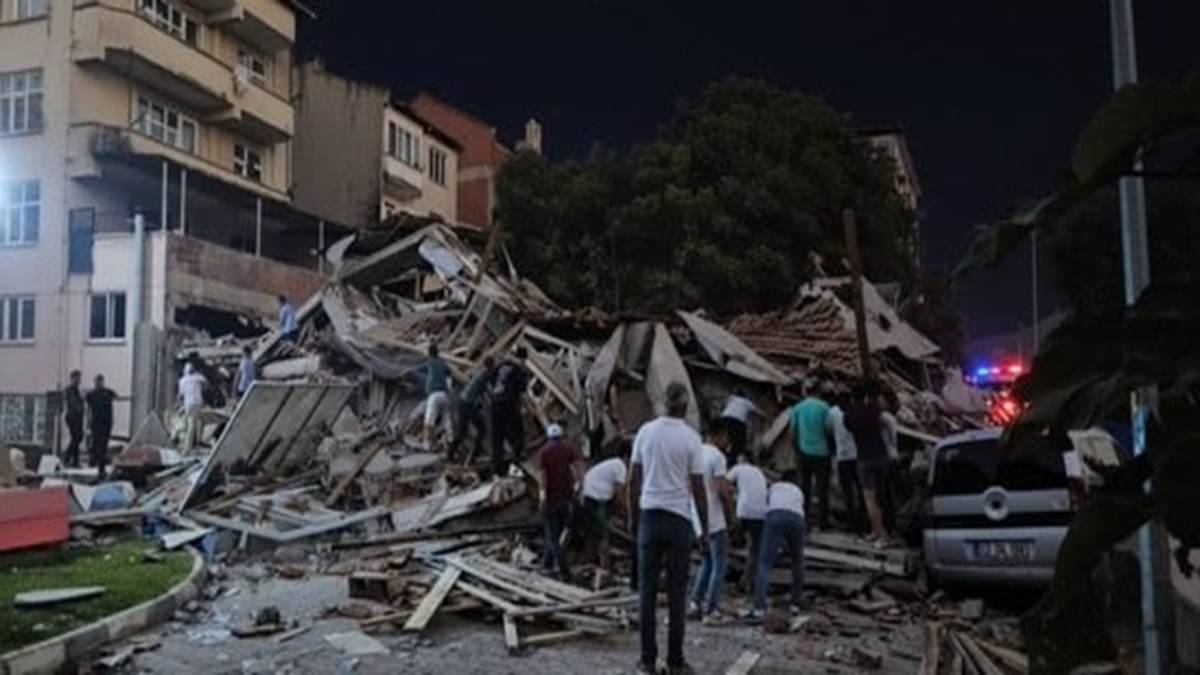Was Turkey spared by luck? Inside the 6.1-Magnitude earthquake that shocked Sindirgi

Turkey hit by strong 6.1-magnitude quake
A strong earthquake measuring 6.1 on the Richter scale struck western Turkey late Monday, October 27, 2025, causing several previously damaged buildings to collapse and sending tremors across major provinces, yet, remarkably, no deaths or injuries were reported.
The quake occurred at 10:48 p.m. local time near the town of Sındırgı in Balıkesir province, according to the United States Geological Survey (U.S.G.S.) and Turkey’s Disaster and Emergency Management Authority (AFAD). With a shallow depth of about 6 kilometers, the tremor was powerful enough to be felt in Istanbul, Bursa, Manisa, and Izmir, sparking brief panic among residents.
Epicenter: Sındırgı at the Heart of the Tremor
Authorities reported that four buildings collapsed in the town center of Sındırgı, though three of them had already been evacuated due to previous structural damage from earlier quakes. The fourth was a closed store, minimizing the human toll.
Local governor Ahmet Yılmaz confirmed that no casualties or injuries were recorded but added that search and safety inspections were ongoing across rural areas to ensure no isolated damage had been overlooked.
READ ALSO
Where did 4.3 earthquake strike in San Francisco Bay Area?
Aftershocks Continue Across Western Turkey
Following the main tremor, multiple aftershocks rippled through the region, typical of Turkey’s seismically active zones. Experts from U.S.G.S. noted that such aftershocks can occur days or even weeks after the initial quake, potentially causing further stress on weakened structures.
Residents in Balıkesir and neighboring provinces reported feeling light to moderate shaking through the night, prompting many to stay outdoors as a precaution. Seismologists continue to analyze data and may revise the earthquake’s magnitude or intensity maps as new readings emerge.
Turkey’s Earthquake Risk and Preparedness
Turkey sits atop several major fault lines, including the North Anatolian Fault, one of the world’s most active seismic zones. The region has endured devastating earthquakes in recent decades, including the 2023 Kahramanmaraş quake that killed over 50,000 people, making seismic awareness and preparedness critical.
Authorities have emphasized ongoing building reinforcements and emergency drills, which likely contributed to the low casualty count this time. AFAD reiterated that citizens should maintain emergency kits and remain vigilant for aftershock warnings.
Government Response and Safety Measures
Turkey’s Disaster Management Agency immediately dispatched field teams to assess the structural impact, while electricity and communication lines in affected areas were restored overnight. Local municipalities urged residents not to return to unstable buildings until inspections were completed.
No tsunami alerts were issued, and transportation across western Turkey continued without major disruption.
Seismologists Warn Against Complacency
Experts caution that the lack of casualties should not lead to complacency. Dr. Safak Timur, a seismologist quoted by The New York Times, noted that “the area remains under tectonic stress, and more moderate quakes are possible in the coming weeks.”
He added that accurate monitoring and early-warning systems remain vital to preventing larger-scale disasters in the future.
A Reminder of Turkey’s Fragile Geography
While Monday’s 6.1-magnitude quake may not have claimed lives, it serves as another reminder of Turkey’s precarious position on shifting plates. As engineers inspect older structures and reinforce vulnerable ones, the country’s resilience once again hinges on preparation, not luck.
FAQs
Q1: Where did the earthquake hit in Turkey today?
The 6.1-magnitude earthquake struck near Sındırgı in Balıkesir province, western Turkey, at 10:48 p.m. local time on October 27, 2025.
Q2: Was anyone killed or injured in the Turkey earthquake?
No casualties or injuries were reported, as most collapsed buildings were unoccupied or previously evacuated.
Q3: What was the magnitude of the Turkey earthquake?
The U.S.G.S. recorded a 6.0-magnitude quake, while Turkey’s AFAD measured it at 6.1.
Q4: Which cities felt the earthquake?
Residents in Istanbul, Izmir, Bursa, and Manisa felt tremors, with moderate shaking reported across western Turkey.
Q5: Are aftershocks expected after the Sindirgi earthquake?
Yes. Experts confirmed several aftershocks and warned that more could occur over the coming days.
Q6: What should people do during a Turkish earthquake?
Authorities advise staying indoors during shaking, taking cover under sturdy furniture, and having an emergency survival kit ready at all times.
Q7: Why is Turkey prone to earthquakes?
Turkey lies along the North Anatolian Fault, a highly active tectonic boundary between the Eurasian and Anatolian plates, making it one of the most earthquake-prone countries in the world.

